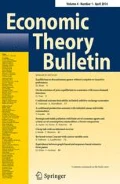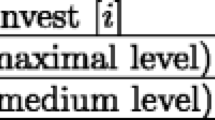Abstract
This paper presents a model of the evolution of the hedonic utility function in which perception is imperfect. Netzer (Am Econ Rev 99(3):937–955, 2009) considers a model with perfect perception and finds that the optimal utility function allocates marginal utility where decisions are made frequently. This paper shows that it is also beneficial to allocate marginal utility away from more perceptible events. The introduction of perceptual errors can lead to qualitatively different utility functions, such as discontinuous functions with flat regions rather than continuous and strictly increasing functions.




Similar content being viewed by others
Notes
See Kahneman and Tversky (1979). For a recent review on prospect theory, see Barberis (2013). Amos Tversky famously quipped that “there once were species that did not exhibit loss aversion and they were now extinct,” (as quoted by Richard Thaler in an interview with the Royal Institute of International Affairs, chathamhouse.org).
Note that limited perception of happiness is different from limited perception of the alternatives. If the x is perceived with a noise, then evolution will operate on the senses needed to distinguish one alternative from another. In this model, however, we are interested in the consequences of perceiving utility U(x) with noise.
Notice also a similarity with the drift-diffusion model of decision-making (Fehr and Rangel 2011).
If Z and \(Z'\) are iid, \(Z^s\equiv Z-Z'\sim Z'-Z = -(Z-Z')=-Z^s\), which implies that \(Z^s\) is a symmetric random variable.
It is a well-known result that if a space X is sequentially compact, and if a function f is sequentially continuous, then f achieves a maximum in X. For completeness, here is a proof: Let \(\alpha \equiv \sup _{x\in X}f(x)\). Then, \(\alpha \in \mathbb {R}\cup \{\infty \}\). Then, \(\exists \{x_n\}_{n=0}^\infty \in X\), such that \(f(x_n)\rightarrow \alpha \). By sequential compactness of X, \(\exists x^*\in X\) and \(\exists \) a subsequence \(\{x_{n_k}\}\) such that \(x_{n_k}\rightarrow x^*.\) By sequential continuity, \(f(x_{n_k})\rightarrow f(x^*)\). Because \(\{f(x_{n_k})\}\) is a subsequence of \(\{f(x_n)\}\), then \(f(x_{n_k})\rightarrow \alpha \Rightarrow \alpha = f(x^*)\).
See Elsgolc (2007).
We already discussed existence and uniqueness, but see Appendix C for the second-order conditions.
I used Knitro, via Matlab, to solve a discrete version of the optimization problem. The codes are available upon request or at home.uchicago.edu/ jtudon.
In other words, between two weights, the agent notices only differences of, say, 10% or more. See Sinn (2003).
Steiner and Stewart (2016) take a different approach: they consider noise in the information processing of a prospect versus a safe option, which leads to a probability weighting function.
For example: if \(u=(5\ 2\ 3) \Rightarrow S(u)=(2\ 5 \ 3)\).
References
Barberis, N.C.: Thirty years of prospect theory in economics: a review and assessment. J. Econ. Perspect. 27(1), 173–196 (2013)
Chernozhukov, V., Fernández-Val, I., Galichon, A.: Improving point and interval estimators of monotone functions by rearrangement. Biometrika 96(3), 559–575 (2009)
Dawkins, R.: The Selfish Gene, 2006th edn. Oxford University Press, New York (1976)
Elsgolc, L.D.: Calculus of Variations, Dover edn. Dover, Mineola (2007)
Ely, J.C.: Kludged. Am Econ J Microecon 3(11), 10–231 (2011)
Fehr, E., Rangel, A.: Neuroeconomic foundations of economic choice-recent advances. J Econ Perspect 25(4), 3–30 (2011)
Herold, F., Netzer, N.: Second-best probability weighting (2015)
Kahneman, D., Tversky, A.: Prospect theory: an analysis of decision under risk. Econometrica 47(2), 263–292 (1979)
McFadden, D.: Conditional logit analysis of qualitative choice behavior. In: Zarembka, P. (ed.) Frontiers in Econometrics, Chapter 4, pp. 105–142. Academic, New York (1974)
Montesinos, V., Zizler, P., Zizler, V.: An Introduction to Modern Analysis, 1st edn. Springer, Berlin (2015)
Netzer, N.: Evolution of time preferences and attitudes toward risk. Am Econ Rev 99(3), 937–955 (2009)
Rayo, L., Robson, A.J.: Biology and the arguments of utility. Cowles foundation discussion paper No. 1893R. (2014). https://doi.org/10.2139/ssrn.2424793
Rayo, L., Becker, G.S.: Evolutionary efficiency and happiness. J Polit Econ 115(2), 302–337 (2007)
Robson, A.J.: The biological basis of economic behavior. J Econ Lit 39(1), 11–33 (2001)
Robson, A.J., Samuelson, L.: The evolutionary foundations of preferences. Handbook of Social Economics. Elsevier, Oxford (2010)
Sinn, H.-W.: Weber’s law and the biological evolution of risk preferences: the selective dominance of the logarithmic utility function, 2002 Geneva risk lecture. Geneva Pap Risk Insur Theory 28(2), 87–100 (2003)
Steiner, J., Stewart, C.: Perceiving prospects properly. Am Econ Rev 106(7), 1601–1631 (2016)
Author information
Authors and Affiliations
Corresponding author
Additional information
Thanks to Benjamin Brooks, Alex Frankel, Emir Kamenica, Philip Reny, Luis Silvestre, Balázs Szentes, Richard Van Weelden, and workshop participants at the University of Chicago.
Appendices
Lemma 2
Lemma 2
For any \(U\in \mathcal {U}\), exists a monotone, non-decreasing function \(U^*\in \mathcal {U}\), such that \(V[U]\le V[U^*]\).
Proof
This proof is not as trivial as it seems, since changing U at any point will change the whole integral. The strategy will be to consider simple functions first, and then apply the dominated convergence theorem to prove the general case.
The objective function can be written as:
where \(K=\mathbb {E}[X]+\int _0^1\int _y^1(y-x)f(x)f(y){\text {d}}x{\text {d}}y\).
Suppose that \(U_n\) is a simple function that is constant on the intervals \(\left( \frac{s-1}{n},\frac{s}{n}\right] \), \(s = 1,\dots ,n.\) Each simple function of this form can be written as the step function \(U_n(x)= \sum _{s=1}^n u_s \mathbb {1}\left\{ \left( \frac{s-1}{n},\frac{s}{n}\right] \right\} (x).\) Now, we can define the n-vector u as the vector with values \(u_s\), which is the value that \(U_n(x)\) takes on the sth interval. From this definition, we see that each n vector corresponds to a step function.
We will now define the sorting operator S acting on the vector u as follows. Let l be an integer in \(1,\dots ,n\), such that \(u_l>u_m\) for some \(l <m\). If l exists, set S(u) to be the n-vector with \(u_m\) on the lth position and \(u_l\) on the mth position, and all other elements equal to the corresponding elements of u. If such an l does not exist, set \(S(u) = u.\) Then, S sorts two elements of u in increasing order.Footnote 14
Similarly, let \(x_n\) and \(f_n\) be two simple functions; the idea is that \(x_n\rightarrow x\) and \(f_n\rightarrow f\). With a slight abuse of notation, also let \(x_n\) and \(f_n\) stand for the n vectors with \(x_s\) and \(f_s\) in the sth position. Therefore, we can approximate \(V[U_n]\) with
In Appendix B, I prove the following lemma.
Lemma 3
\(V_n[U_n]\le V_n[S(U_n)]\).
Therefore, if we apply the sorting operator S sufficiently many times to \(U_n\), to a maximum of n times, we find the rearranged vector \(U^*_n\): a vector completely sorted in ascending order. Every application of the sorting operator S improves \(V_n\), and since we apply it a finite number of times, \(V_n[U^*_n]\equiv V_n[S \circ S \circ \dots \circ S U_n ] \ge V_n[U_n].\)
Now that this holds for simple functions, we go for the general case. Since f, U, and the identity are measurable functions, there are sequences of bounded simple functions \(\{f_n\}\), \(\{U_n\}\), and \(\{x_n\}\) converging almost everywhere to f, U, and x. Define the increasing rearrangement of U as
This rearrangement always exists; it is like sorting the values of U in increasing order. This is a quantile function.
From this definition, \(U_n\rightarrow U\) a.e. implies that the rearrangements also converge a.e. to the rearrangement: \(U_n^*\rightarrow U^*\) a.e. (see Chernozhukov et al. (2009) and the references therein). Moreover, \(V_n[U_n]\rightarrow V[U]\) and, since the inequality works for every n, by Lebesgue’s dominated convergence theorem, \(V[U]\le V[U^*]\). \(\square \)
Proofs
Proof of Lemma 3
Consider the following expression:
First, observe that \(G(u_i-u_j)-G(Su_i-Su_j)=0\) for all \(i,j\ne l,m.\) Next, for \(i=l\), there are \(j=1,\dots ,l\) summands and for \(i=m\), there are \(j=1,\dots ,m\) summands. Similarly, for \(j=l\), there are \(i=l,\dots ,n\) summands and for \(j=m\), there are \(i=m,\dots ,n\) summands. However, we are double-counting three summands, but two are zero: The non-zero summand corresponds to \(j=l\) and \(i=m\). Finally, note that \(G(u_m-u_j)-G(Su_m-Su_j)=-[G(u_j-u_m)-G(Su_j-Su_m)]\). Thus,
At this point, we use the definition of S and conclude that the preceding sum equals:
Now, we have to show that the preceding expression is non-positive.
By assumption \(u_l> u_m\). Moreover, G is a non-decreasing cdf and \(x_l<x_m\). Therefore, \(G(u_i-u_l)-G(u_i-u_m)\le 0\).
On the other hand, \((x_i-x_l)f_l-(x_i-x_m)f_m\ge 0\): Suppose that \(f_l>f_m\), then \((x_i-x_l)f_l>(x_i-x_m)f_l>(x_i-x_m)f_m\). Now suppose that \(f_l\le f_m\), then \(f_m(x_m-x_i)>f_m(x_l-x_i)\ge f_l(x_l-x_i)\), which implies that \((x_i-x_l)f_l-(x_i-x_m)f_m\ge 0\).
Therefore, we conclude that \(V_n[U_n]- V_n[S(U_n)]\le 0\). \(\square \)
Proof of Lemma 1
Define \(h_y(x)\equiv 2(y-x)f(x)f(y)g\left( U(y)-U(x)\right) \), so that \(I(y)=\int _0^1 h_y(x){\text {d}}x\). Since \(U\in \mathcal {M}\), \(h_y\) is (Lebesgue) integrable \(\forall y\in [0,1]\). Since f and g are bounded, there exists a function B, such that \(|h_y(x)|\le B\) almost everywhere. Now, fix y and consider a sequence \(\{y_n\}_{n=1}^\infty \in \mathbb {R}\) converging to y. Then \(h_{y_n}\rightarrow h_y\) a.e. and \(|h_{y_n}(x)|\le B\) a.e. Therefore
\(\square \)
Second-order conditions
For the sake of completeness, note that \(\left. \dfrac{\partial ^2}{\partial ^2 \alpha }V[U+\alpha \delta U]\right| _{\alpha =0}\) is equal to
since \(U\in \mathcal {M}\).
Corollaries
Proof of Corollary 4
Consider \(x\in [0,a]\) and recall that \(I(x)\le 0\) and \(U(x)=0\) for such x. In particular \(I(a)=0\) and \(U(a)=0\). In other words,
The function \(w(y,\sigma )\equiv e^{-\frac{U(y)^2}{2\sigma ^2}}\) is a positive weight. Since U(y) is monotone, w is increasing in \(\sigma \) and decreasing in y. In particular, \(w(y,\sigma )=1\) for \(y\in [0,a)\) and for any \(\sigma \), and \(w(y,\sigma )<1\) for \(y\in [a,1]\). Moreover, \((a-y)>0\) for \(y\in [0,a)\) and \((a-y)\le 0\) for \(y\in [a,1]\). Since f(y) is fixed, it follows that increasing \(\sigma \) increases the weight of the negative part of the integral, relative to the positive part. To maintain \(I(a)=0\), the positive part must increase in size, and thus, the interval [0, a) must expand. Then, a must increase.
The case of b is analogous. \(\square \)
Proof of Corollary 5
As in Corollary 4, consider
where \(\text {B}(\alpha ,\alpha )\) is the beta function, which becomes irrelevant. As \(\alpha \) increases, the weight shifts towards 1/2 and away from the interval [0, a), which is the positive part of the integral. Since the equality \(I(a)=0\) must be maintained, the interval must expand. Then, a must increase.
The case of b is analogous. \(\square \)
Proof of Corollary 6
As in Corollary 5, consider
where \(\text {B}(\alpha ,\beta )\) is the beta function, which becomes irrelevant. As \(\alpha \) increases, the weight shifts away from the interval [0, a), which is the positive part of the integral. Since the equality \(I(a)=0\) must be maintained, the interval must expand. Then, a must increase.
For b, consider
As \(\alpha \) increases, the weight shifts towards the interval (b, 1], which is the negative part of the integral. Since \(I(b)=0\) must hold, the interval (b, 1] must shrink. Then, b must increase. \(\square \)
Rights and permissions
About this article
Cite this article
Tudón M., J.F. Perception, utility, and evolution. Econ Theory Bull 7, 191–208 (2019). https://doi.org/10.1007/s40505-018-0153-8
Received:
Accepted:
Published:
Issue Date:
DOI: https://doi.org/10.1007/s40505-018-0153-8




